

 The Accurate Reloading Forums
The Accurate Reloading Forums  THE ACCURATE RELOADING.COM FORUMS
THE ACCURATE RELOADING.COM FORUMS  Other Topics
Other Topics  Recipes for Hunters
Recipes for Hunters  Gravlax for Superbowl - 2012
Gravlax for Superbowl - 2012Go  | New  | Find  | Notify  | Tools  | Reply  |  |
| one of us |
Gravlax for Superbowl - 2012 It's that time of year again - the SuperBowl is a little over a week away. In keeping with tradition, I'll be preparing gravlax in much the same way as my Swedish ancestors. I am going to make this a complete, "signature" post, with history, recipe and other notes lifted from previous years, followed by step-by-step pictures; having said that, I do recommend that you take the time to review the links below, as there is plenty of good supplemental information to be found in them. In chronological order, here are those previous posts: http://foodsoftheworld.activeb...andinavian-specialty http://foodsoftheworld.activeb...x-for-superbowl-2011 A bit of history from Wikipedia:
When selecting salmon for this project, there are a few things you should know in order to be safe, as there is a very slight, but genuine, danger of food-borne illness and parasites in choosing poorly. After all, we are talking about raw fish here, and even though raw fish is commonly eaten all over the world, that is no reason not to exercise some common sense and good judgment. First, if you are trying to choose between wild-caught or farm-raised salmon, keep this in mind:
Whether you ultimately choose wild-caught or farm-raised salmon, either will be free of potential food-borne illness and safe for consumption, if they have been properly frozen. In doing some research on this, all sources seem to agree that commercial packagers of salmon freeze it to 40 degrees below zero (F or C is the same at that temperature) as an industry standard, specifically to eliminate the possibility of parasites. If you are using commercially-packaged salmon, you will have no worries of food-borne illness. Even if you store your commercially-packaged salmon in your home freezer, and it is only at zero degrees, the thing to remember is that it was brought down to 40 below at the packaging center, and any danger was eliminated then and there. If you are using wild, fresh-caught salmon that has never been frozen as per industry standards, then there is some small chance of food-borne illness and that you really might be playing Russian roulette, but no more so than anyone who eats raw clams, oysters, ceviche etc, as far as I can see. A trusted friend with many years of experience in the food safety industry put it this way:
The bottom line is that it is up to, the individual reader of this post, to decide whether to try this or not - but if you ask my opinion, I will tell you that this stuff is too good to simply dismiss simply because you think you might be choosing between "taking a chance" or missing out on what is definitely some very good, traditional Scandinavian eating. When good judgment is combined with proper preparation, this product is no more or less dangerous than any other food prepared at home. Please note that this all refers to salt-water fish. I absolutely would not consider making gravlax, sushi or sashimi out of freshwater fish that I had caught and packaged myself. For those, I would brine and hot-smoke to a safe temperature of 140 degrees. There might be a safe length of time to hold them at zero degrees F - say, 30 days - but I won't try it until I know for sure. Anyway, once you select your salmon, the process is easy. Following the formula provided by Time/Life's Foods of the World - The Cooking of Scandinavia, 1968, here is all you need in order to create a very traditional gravlax: 1/4 cup non-iodized salt 1/4 cup sugar 2 Tablespoons freshly-ground black pepper 1 large bunch of fresh dill 1 fillet of salmon A note on salt: I prefer to use coarse, natural sea salt, as this is what my Nordic ancestors would have used when making this. Natural sea salt has wonderful flavour anyway, so it's kind of a win-win situation. Having said that, any non-iodized salt can be used with fine results. A note on sugar: I prefer to use raw (turbinado) sugar, since I figure this is the closest widely-available sugar to what would have been used back in the day. The larger grains of the turbinado will also go well with the coarse-ground peppercorns and sea salt that will be used. Having said that, any sugar can be used with fine results. A note on pepper: I prefer to use a mixed "peppercorn medley" of different colours on the grounds that by the time pepper had traveled up to Scandinavia (via trade routes), it would probably not be the pure, black-only pepper that would be found closer to the source; rather, I figure it would most likely be comprised of a few different varieties of peppercorn (black, white, green, pink etc) to reflect the traders' blending of the last of their inventory in an effort to provide a "full load" at the far end of their route. Having said that, pure black pepper can of course be used. A note on dill: I prefer fresh dill, but have learned to be prepared in case circumstances force me to use dried dill, or a combination of both. During the winter months, the dill available might not be the greenest and featheriest that it can be. It stands to reason that, back in the day, folks would have supplemented any substandard or unavailable fresh dill with dried dill from their stores. With that in mind, I will always use fresh dill if it is available; but if not, a light dusting of dried dill weed will be just fine. If using dried dill weed, keep in mind that dried dill is going to be much more concentrated than fresh, so use it sparingly. Using dill seed (rather than weed) is not recommended; my reasoning behind this is that a "bitter" taste in gravlax has been reported when using dill seed, which makes sense, as I have read that when canned tomatoes have an abundance of seeds, there can be a bitterness that comes from them, possibly a result of the salting and/or storage, I am not sure. Also, I have heard that cucumber seeds can impose a bitterness in dishes where cucumbers are used. As mentioned in the Wikipedia article above, gravlax is traditionally served with a wonderful mustard sauce, prepared for this purpose, called gravlaxsås (or sometimes hovmästarsås). Some information on this was found on a Swedish food site; please bear with the clunky Google translation:
I have made this sauce, and it was truly wonderful, a perfect compliment for gravlax. Here is the recipe, from the abovementioned Swedish site (with some notes for clarification):
When I prepared it, I chose to use extra virgin olive oil rather than something "neutral" like canola. Results were very, very good with a sweet-tart tang and a good bite from the dill, pepper and other seasonings. My only regret is that I had no fresh dill to chop up and use at the time - the dry dill weed that I did use is quite adequate, but it was ground quite fine and therefore ended up coloring the mustard a bit: 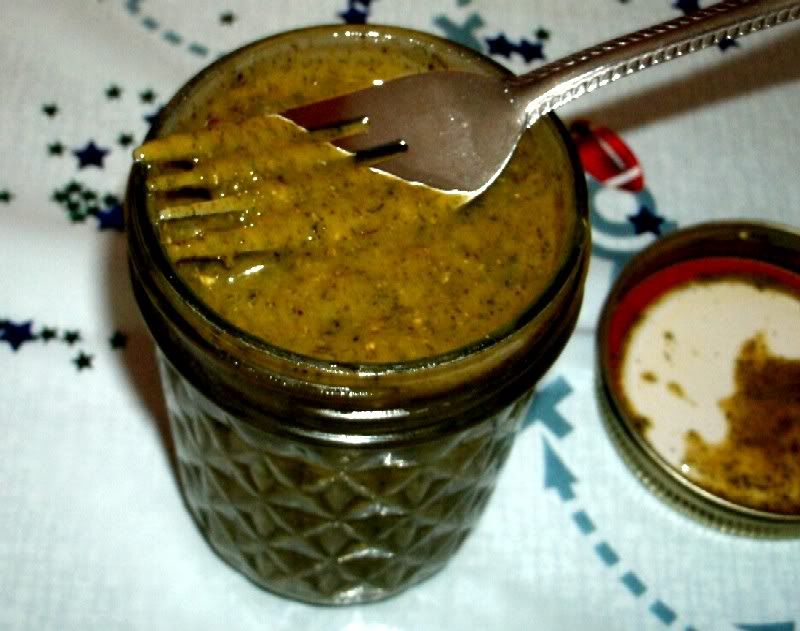 No big deal, it tastes great either way. More on this to be posted as the gravlax is prepared. If you just can't wait, and want to give this a try now in time for your own SuperBowl gravlax, consult the links above for full step-by-step procedures. | ||
|
| One of Us |
This sounds great. Much more complicated than my annual SuperBowl fare: Chile con Queso. Venison Chorizo -- take out of links, fry it up and drain (some of the) fat. Mix in with velvetta and some cans of Roi-Tel tomatoes/peppers. Heat gently, don't boil. Add jalepenos, serranos, or if you are brave -- chile pequins -- to suit how hot you want it to be. Great Queso. Serve with tortilla chips, preferably freshly made. You can make a meal of this. You can skip the chorizo, it's still good, but that's a big mistake. | |||
|
| one of us |
Sounds good lavaca! I'm not sure how this became a SuperBowl tradition - I think the game just happened to co-incide with the first time I made it, and that was that. Bad news - I had myself quite the camera SNAFU tonight. Good news - I didn't have any camera SNAFU last year or the year before, and both those times were pretty much the same as what I did tonight - so for those of you who are interested in trying this, we're good to go. Here's the procedure, by the numbers.... Here's what you need: 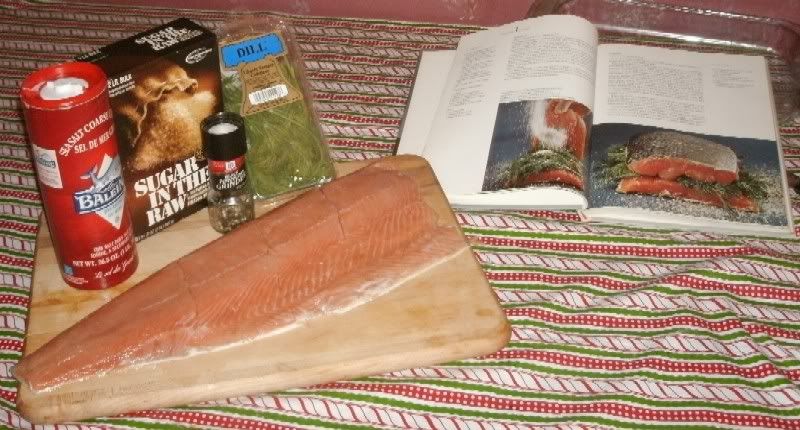 I considered using honey rather than turbinado sugar, in order to really take this back to the good old days, but we had none in the house. Also, as mentioned above, I used a "peppercorn medley," rather than strictly black pepper. I considered adding cracked mustard seed, but decided not to in the end, opting to go fairly traditional. Amounts are as follows: non-iodized salt - 1/4 cup sugar 1/4 cup freshly-ground black pepper - 2 tablespoons 1 large bunch of fresh dill 1 fillet of salmon The salmon i used was darker than the one pictured above - a rich, reddish/orangish hue that was closer to this:  First, I trimmed a strip of belly meat off, about an inch wide. Then, I measured the salt, pepper and sugar, stirring them together until they were thoroughy mixed:  Next, I gave the dill a rough chop:  This was about all the prep that was needed, so I got down to business and put this together. It's pretty easy, just lay down the centre-cut fillet, then generously apply about half of the salt/sugar/pepper curing mixture: 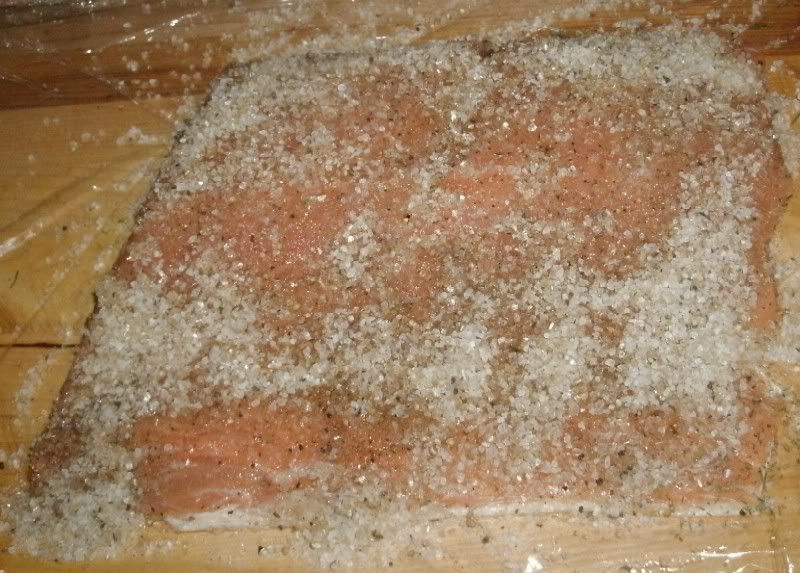 Next, arrange the dill on top of the center-cut fillet, and then take about 2/3 of the cure that is left and apply it to the other (tail) half of the fillet:  Then, spread the last of the cure on top of the dill: 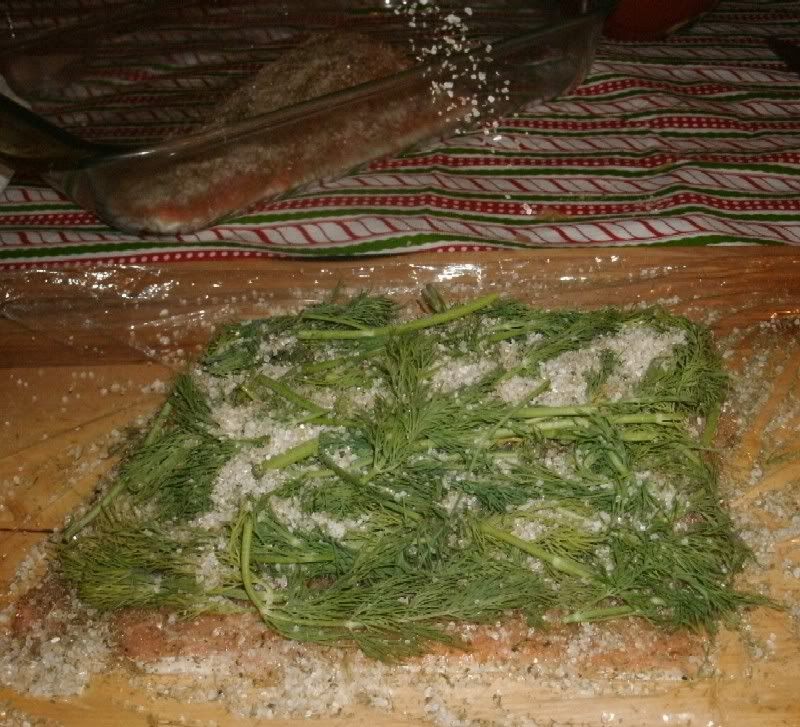 And then sandwich the two fillets together, keeping as much cure mixture and dill in place as possible. NOTE - The important thing when sandwiching them together is to put the thickest part of one fillet up against the thinnest part of the other fillet - skin side out - so that the thick parts of each fillet are evened out and not sitting on top of each other. If curing mixture or dill falls out, try to get it back in. This can be tough to do with the curing mixture, but if you assemble the gravlax on a cutting board or plate, you can gather it up and make sure it is packaged with the gravlax. From here, you have two options: 1) You can double- or triple-wrap it in saran wrap, tight as possible: 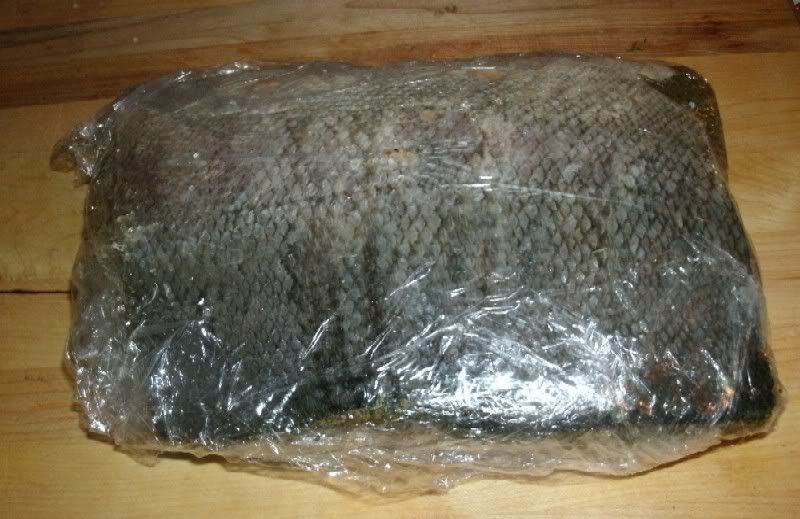 or 2) You can vacuum-seal the gravlax: 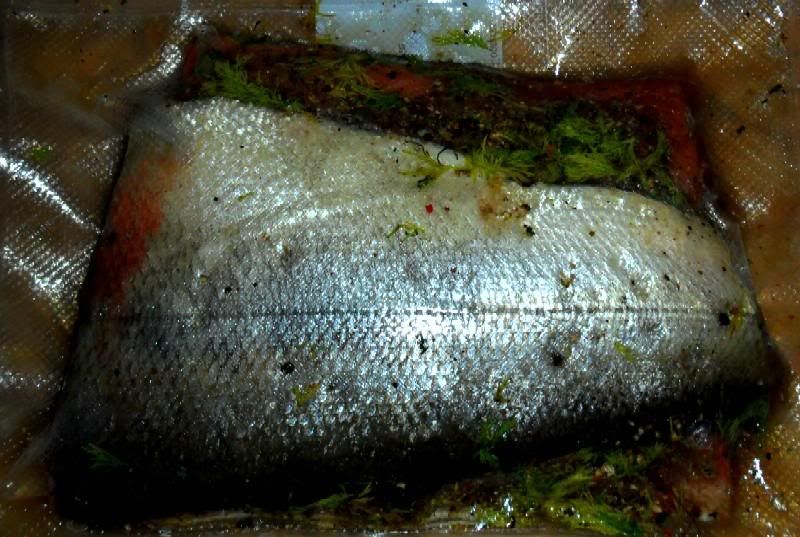 There are pros and cons with each choice. The saran wrap is much easier and less messy to package, and works just fine. On the other side of the coin, some of the curing juices always seem to seep out. The vacuum sealing does help to "press" the fillets together and draw out the moisture, while also working the cure in, so that the gravlax seems to cure faster and seems more "dry" when finished. But on the other hand, it is a pain to work the fillet into the bag, and any stray granules of cure will impede the sealing process, as will any extra moisture. Either way works; I personally prefer the vacuum seal. Whichever way you do it, the next step is the same. Put the packaged gravlax into a shallow baking dish, and then set it somewhere out of the way in your refrigerator, weighing down the top of the salmon with something fairly heavy such as a box of rock salt, a juice container filled with water, or something similar. The salmon takes 48 hours to cure, at a minimum. Doing this Tuesday night, mine will cure for about 4.5 days, which is just fine. Each day, it is important to turn the package over, once in the morning and once at night, so that the cure and the resulting brine can be evenly distributed throughout the fillets and get that wonderful, Scandinavian essence into every corner. When your gravlax is finished and you are ready to enjoy it, simply remove it from the packaging, rinse it off (or you can do as I prefer and simply scrape the cure off, leaving bits of pepper and dill behind), then pat it dry with paper towels. Slice as thinly as possibe on a cutting board and enjoy - either by itself, or with your favourite bread, toast, crackers or whatever, along with a condiment such as mustard or the aforementioned gravlaxsås. I should have my camera issues taken care of by tomorrow evening, so I will see about doing a step-by-step of the procedure for this wonderful Scandinavian sauce. So, if any of you are interested in trying this in time for the SuperBowl, you have a couple of days to get it done! I believe I've covered the procedure, but if there are any questions, just ask. | |||
|
| one of us |
Sir: You are a WONDERFUL resource!!! Thank you. Alex | |||
|
| one of us |
hey, alex - i appreciate the kind words ~ hopefully, i am able to pass along some of what i have learned; if i can do that, then i've done what i set out to do. this eyar's gravlax didn't turn out quite as good as i wanted it to. i'll be posting more on it when i ahve the time and the pictures ready, but to make a long story short, the salmon fillet was too thin and it cured for too long a time - it might also have been rpessed too hard. more later.... | |||
|
| one of us |
Say, everyone - Sorry it took so long to get back to this; unfortunately, it didn't go quite as well as I had hoped it would. First, allow me to say that the method as outlined in this and my other postings on the subject is absolutely sound; Any errors are mine alone, and I think that I simply had two pieces of bad luck this year: a) the salmon fillet I used was just too thin. I had used this brand/type of salmon before, but I think this time around I simply got a thinner piece, that might also have been of slightly inferior quality. The lesson to take from this is to use the best salmon you can get when making gravlax; this goes without saying, but also make sure that it isn't too thin - I'm going to go out on a limb and say that anything less than 3/8 of an inch thick at it's thinnest point (except at the edges of the belly section) is too thin. b) I let this cure far too long - 3-4 days is optimum and I believe after that, it gets to be a little much. Also, I may have had it pressed too hard during curing. It had been vacuum sealed, so I probably dind't need to press it at all, but hindsight is 20/20. These factors, along with the thin-ness of the fillet, evidently resulted in a breakdown of the tissues and a mushy product that was also far too salty. Anyway, here's what I found on the morning of the Superbowl, as I prepared removed the gravlax from the vacuum sealed package:  The colour is good, and the wet-spinachy look of the dill is perfectly normal, but compared to projects of previous years, the salmon fillets looked a little flat and "shriveled." Also they were very "stiff," which is something that has never really happened before. This was my first clue that things weren't going to turn out as well as I had hoped this year. This picture shoes just how much of a challenge it was to cut thinly, which is crucial for gravlax: 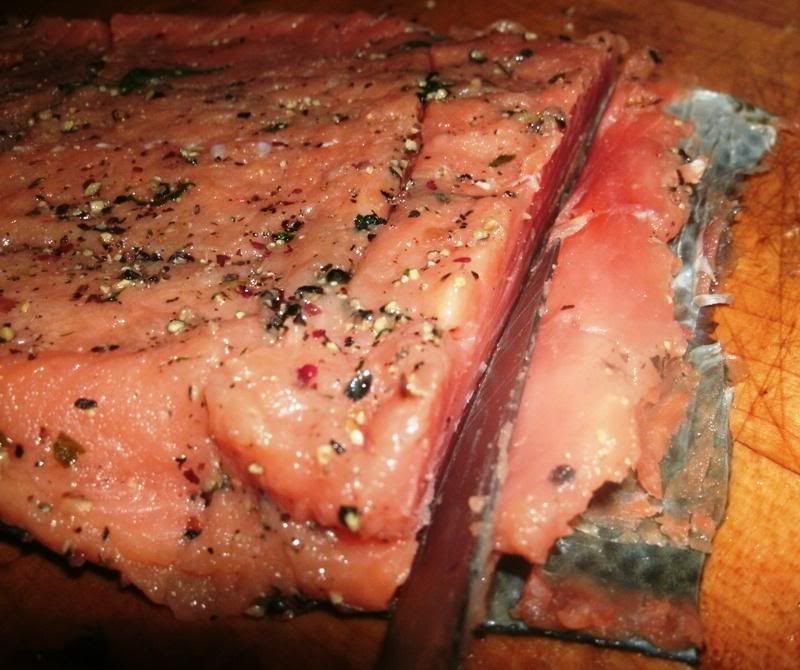 If I attempted a cut that was any thinner than this, the meat would simply mush down and fall apart, so I ended up making much thicker cuts than usual, which didn't help texturally:  The actual flavour of the gravlax was pretty good, with the black pepper and the dill coming through just right, and the sweetness of the sugar coming through very nicely as well. These elements provide the "zing" on the tongue that is a hallmark of a lot of thinly-sliced, "raw" cured meats, but it wasn't as intense or as pleasurable due to the thickness of the cut, which made it rather difficult to chew and swallow. Normally, with very-thinly sliced cuts of these types of meats, the product nearly melts ono the tongue and sends several wonderful sensations all along the taste buds from the different flavours and spices, but not this time. Unfortunately, probably due to the thin-ness of the fillet and the length of time curing, it was also extremely salty, to the point of being just too much, and it simply wasn't as popular with the crowd as it has been the two previous times that I have made it. Rinsing off the fillet this time might have helped, but the way that it was mushy and almost falling apart, I didn't want to risk it. I kept the bulk of the sliced gravlax in the refrigerator in order to stay cold; here we are with some of the thinner pieces laid out for serving: 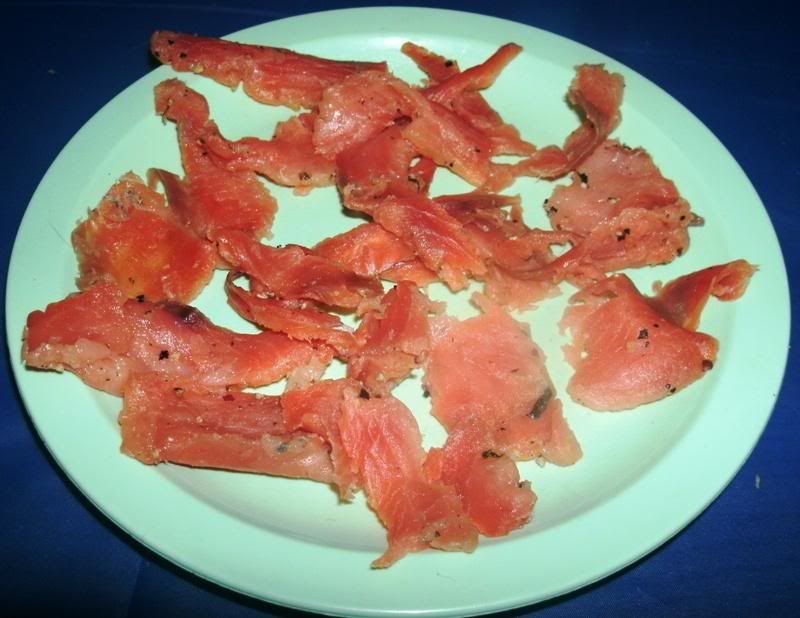 On a brighter note, the hovmästarsås turned out great, with a very nice balance between the dill, mustard and sweet flavours, and the tang of the vinegar helping to bring out the best of all taste sensations. Here it is, spread on some of the gravlax on a townhouse-type cracker:  Even though the gravlax didn't turn out as well as I would have liked, our Superbowl layout was still pretty good, so we weren't too bummed out about it:  It looks like someone was doing a little pre-game grazing, and forgot to clean up afterthemselves ~ Anyway, that does it for 2012 ~ we'll see how it goes next year! | |||
|
| Powered by Social Strata |
| Please Wait. Your request is being processed... |
|
 The Accurate Reloading Forums
The Accurate Reloading Forums  THE ACCURATE RELOADING.COM FORUMS
THE ACCURATE RELOADING.COM FORUMS  Other Topics
Other Topics  Recipes for Hunters
Recipes for Hunters  Gravlax for Superbowl - 2012
Gravlax for Superbowl - 2012

Visit our on-line store for AR Memorabilia

